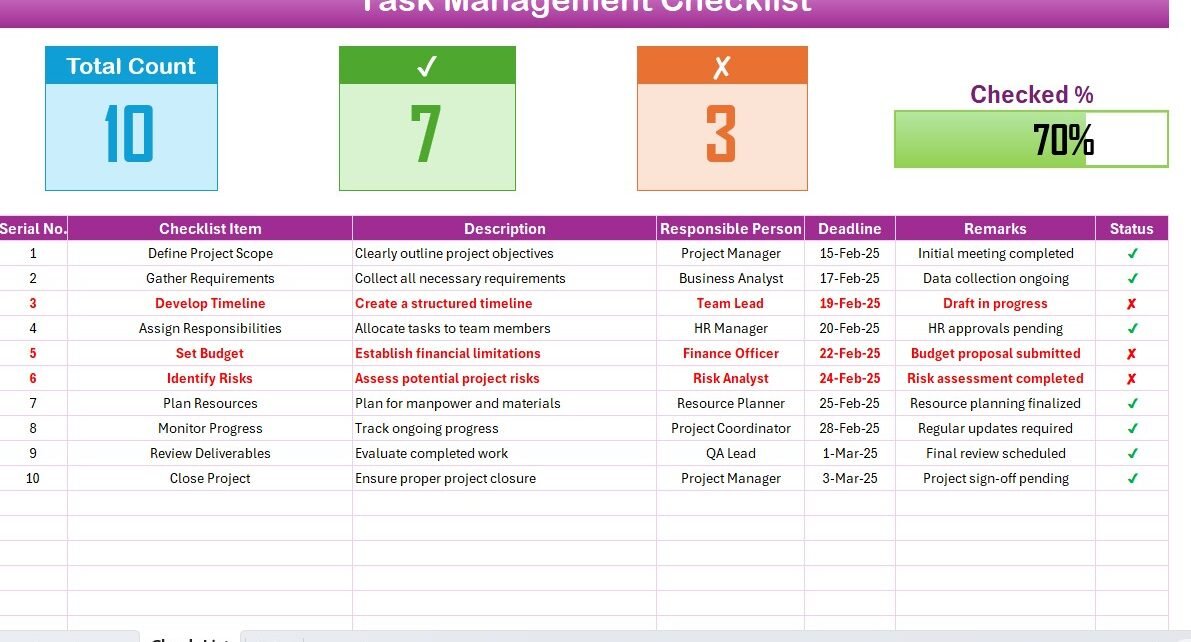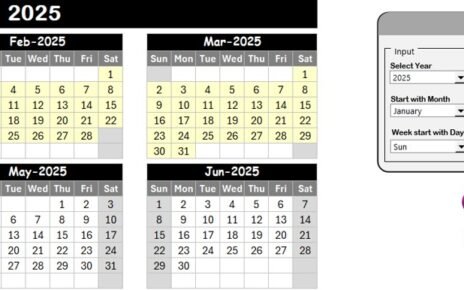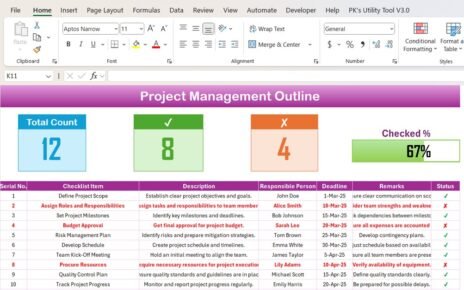Managing tasks efficiently is crucial for any project’s success. A Task Management Checklist in Excel provides a structured approach to track, assign, and complete tasks effectively. With Excel’s versatility, you can create an easy-to-use checklist that enhances productivity and keeps everything organized.
This guide will help you understand how to create, customize, and utilize a Task Management Checklist Template in Excel. We will also cover its benefits, best practices, and frequently asked questions to help you get the most out of this tool.
Click to Task Management
What is a Task Management Checklist in Excel?
A Task Management Checklist in Excel is a ready-to-use template that allows teams and individuals to list tasks, assign responsibilities, track progress, and ensure project completion within deadlines. This structured system provides clarity and accountability for all stakeholders.
Key Features of the Task Management Checklist Template
This template consists of two worksheets:
Task Management Checklist Sheet Tab
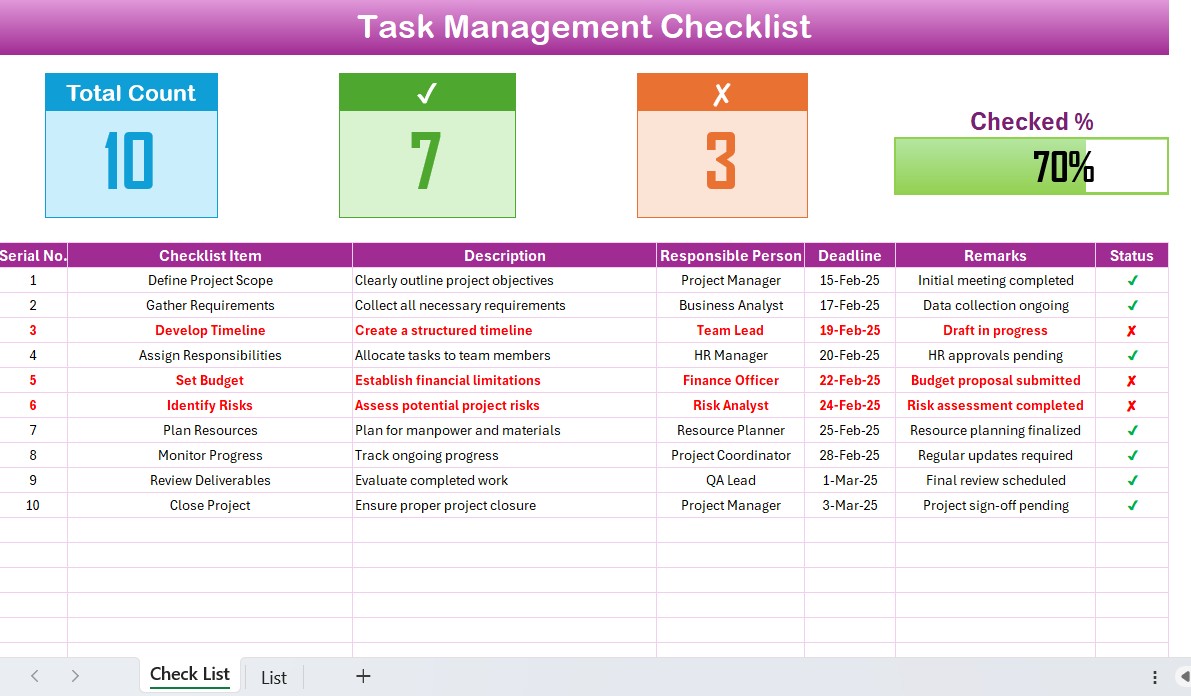
- The primary worksheet for task tracking.
List Sheet Tab
- A reference sheet for creating dropdown lists.
Click to Task Management
Breakdown of the Task Management Checklist Sheet
This sheet is divided into two main sections:
- Top Section: Overview & Progress Tracking
- Total Count: Displays the total number of tasks.
- Checked Count: Counts completed tasks.
- Crossed Count: Shows uncompleted tasks.
- Progress Bar: Graphically represents task completion percentage.
Breakdown of the List Sheet Tab
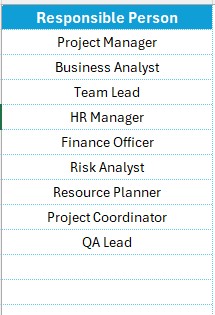
The List Sheet Tab stores a unique list of responsible persons for task assignment. This allows for dynamic drop-down menus in the checklist table, ensuring data consistency and ease of selection.
Advantages of Using a Task Management Checklist in Excel
- Better Organization: All tasks are listed in one place, reducing confusion.
- Increased Productivity: Clear task assignments enhance team efficiency.
- Improved Tracking: Visual indicators like progress bars keep everyone on track.
- Customization Flexibility: Easily modify columns, statuses, and formatting to suit specific needs.
- No Additional Software Required: Works with Excel, making it accessible to most users.
Click to Task Management
Best Practices for Using the Task Management Checklist
- Keep It Simple and Structured: Use clear headings and structured tables to avoid clutter. Stick to necessary details and avoid excessive text.
- Use Conditional Formatting: Apply conditional formatting to visually highlight completed tasks, overdue deadlines, or high-priority items.
- Update the Checklist Regularly: Encourage team members to update task statuses as soon as changes occur. A real-time approach improves efficiency.
- Set Realistic Deadlines: Unrealistic deadlines can lead to stress and inefficiency. Assign achievable due dates for every task.
- Leverage Drop-down Lists: Use Excel’s data validation feature to create drop-down lists for the Responsible Person column. This reduces errors and ensures consistency.
- Use Filters for Better Navigation: Apply Excel filters to sort tasks based on completion status, responsible persons, or deadlines.
- Automate Progress Calculation: Use Excel formulas like COUNTIF to automate the calculation of completed tasks and progress percentages.
Click to Task Management
Frequently Asked Questions
How do I create a Task Management Checklist in Excel?
- To create a Task Management Checklist in Excel:
- Open Excel and create a new sheet.
- Define column headers (e.g., Task Name, Responsible Person, Deadline, Status).
- Input tasks and assign team members.
- Use drop-down lists for easier selection.
- Apply conditional formatting for better visualization.
- Track progress using COUNTIF formulas and progress bars.
Can I share my Task Management Checklist with my team?
Yes! Excel allows collaboration via OneDrive or Google Sheets. You can also save it as a shared document and allow multiple users to update it simultaneously.
How do I automate progress tracking in Excel?
- You can use the following formula to calculate task completion percentage:
- =COUNTIF(Status Column, “✔”) / COUNTA(Status Column) * 100
- Replace Status Column with the actual range of the status column in your sheet.
Is there a way to create notifications for deadlines?
While Excel itself doesn’t have built-in notifications, you can set up conditional formatting to highlight approaching deadlines. Alternatively, Power Automate or Outlook Reminders can be used for alerts.
Can I customize this template for personal use?
Absolutely! You can add more columns, change formatting, or integrate it with VBA macros to enhance automation.
Conclusion
Using a Task Management Checklist in Excel ensures better organization, improved productivity, and efficient task tracking. Whether for project management, team collaboration, or personal use, this template provides a structured way to manage responsibilities and deadlines.
Click to Task Management
Visit our YouTube channel to learn step-by-step video tutorials
View this post on Instagram
